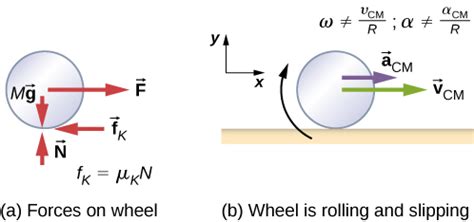Introduction
In the realm of physics, understanding the intricate dynamics of objects in motion is paramount. One crucial concept that arises in this context is the notion of rolling without slipping. This phenomenon occurs when an object, such as a wheel or ball, rotates about an axis while maintaining contact with a surface without any sliding motion.

To fully grasp the mechanics behind rolling without slip, it is essential to construct a free body diagram (FBD) that accounts for all the forces acting on the object.
Free Body Diagram for Rolling Without Slip
The FBD for an object rolling without slip includes the following forces:
- Gravitational force (mg): The weight of the object acting vertically downward.
- Normal force (N): The force exerted by the surface on the object, perpendicular to the contact surface.
- Frictional force (f): The force that opposes the object’s impending sliding motion.
Deriving Equations of Motion
Using the FBD, we can derive the equations of motion that govern rolling without slip:
- Translational motion: The object accelerates along the horizontal direction with an acceleration a = f/m.
- Rotational motion: The object accelerates angularly about its center of mass with an angular acceleration α = f/Ir², where I is the moment of inertia about the center of mass.
Force Balance
In the case of rolling without slip, the frictional force f plays a crucial role in balancing the forces:
- Horizontal forces: f balances the gravitational force mg sin θ, where θ is the angle of inclination of the surface.
- Vertical forces: N balances the gravitational force mg cos θ.
Applications of Rolling Without Slip
The principle of rolling without slip finds numerous applications in various industries and technologies:
- Transportation: Wheels of vehicles roll without slip to provide efficient motion.
- Machinery: Gears and bearings utilize rolling motion to reduce friction and noise.
- Sports: Balls in games like basketball and soccer roll without slip to achieve desired trajectories.
Common Mistakes to Avoid
When analyzing rolling without slip, it is important to avoid the following common mistakes:
- Ignoring the frictional force, which is essential for maintaining no-slip conditions.
- Assuming a constant coefficient of friction, which can vary depending on the materials involved.
- Neglecting the moment of inertia, which affects the angular acceleration of the object.
Conclusion
The free body diagram for rolling without slip provides a comprehensive understanding of the forces acting on an object undergoing this type of motion. The analysis of these forces helps us derive equations of motion and identify its applications across various fields. By avoiding common mistakes, we can accurately apply the principles of rolling without slip to solve real-world problems.
